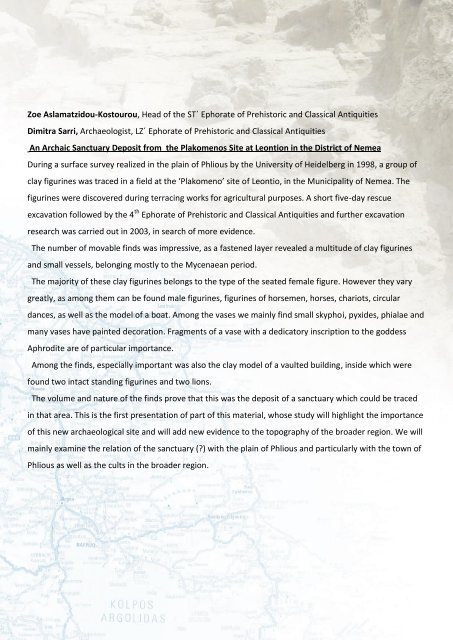ABSTRACTS - The American School of Classical Studies at Athens
ABSTRACTS - The American School of Classical Studies at Athens
ABSTRACTS - The American School of Classical Studies at Athens
Create successful ePaper yourself
Turn your PDF publications into a flip-book with our unique Google optimized e-Paper software.
Ζoe Aslam<strong>at</strong>zidou-Kostourou, Head <strong>of</strong> the ST΄ Ephor<strong>at</strong>e <strong>of</strong> Prehistoric and <strong>Classical</strong> Antiquities<br />
Dimitra Sarri, Archaeologist, LZ΄ Ephor<strong>at</strong>e <strong>of</strong> Prehistoric and <strong>Classical</strong> Antiquities<br />
An Archaic Sanctuary Deposit from the Plakomenos Site <strong>at</strong> Leontion in the District <strong>of</strong> Nemea<br />
During a surface survey realized in the plain <strong>of</strong> Phlious by the University <strong>of</strong> Heidelberg in 1998, a group <strong>of</strong><br />
clay figurines was traced in a field <strong>at</strong> the ‘Plakomeno’ site <strong>of</strong> Leontio, in the Municipality <strong>of</strong> Nemea. <strong>The</strong><br />
figurines were discovered during terracing works for agricultural purposes. A short five-day rescue<br />
excav<strong>at</strong>ion followed by the 4 th Ephor<strong>at</strong>e <strong>of</strong> Prehistoric and <strong>Classical</strong> Antiquities and further excav<strong>at</strong>ion<br />
research was carried out in 2003, in search <strong>of</strong> more evidence.<br />
<strong>The</strong> number <strong>of</strong> movable finds was impressive, as a fastened layer revealed a multitude <strong>of</strong> clay figurines<br />
and small vessels, belonging mostly to the Mycenaean period.<br />
<strong>The</strong> majority <strong>of</strong> these clay figurines belongs to the type <strong>of</strong> the se<strong>at</strong>ed female figure. However they vary<br />
gre<strong>at</strong>ly, as among them can be found male figurines, figurines <strong>of</strong> horsemen, horses, chariots, circular<br />
dances, as well as the model <strong>of</strong> a bo<strong>at</strong>. Among the vases we mainly find small skyphoi, pyxides, phialae and<br />
many vases have painted decor<strong>at</strong>ion. Fragments <strong>of</strong> a vase with a dedic<strong>at</strong>ory inscription to the goddess<br />
Aphrodite are <strong>of</strong> particular importance.<br />
Among the finds, especially important was also the clay model <strong>of</strong> a vaulted building, inside which were<br />
found two intact standing figurines and two lions.<br />
<strong>The</strong> volume and n<strong>at</strong>ure <strong>of</strong> the finds prove th<strong>at</strong> this was the deposit <strong>of</strong> a sanctuary which could be traced<br />
in th<strong>at</strong> area. This is the first present<strong>at</strong>ion <strong>of</strong> part <strong>of</strong> this m<strong>at</strong>erial, whose study will highlight the importance<br />
<strong>of</strong> this new archaeological site and will add new evidence to the topography <strong>of</strong> the broader region. We will<br />
mainly examine the rel<strong>at</strong>ion <strong>of</strong> the sanctuary (?) with the plain <strong>of</strong> Phlious and particularly with the town <strong>of</strong><br />
Phlious as well as the cults in the broader region.

















